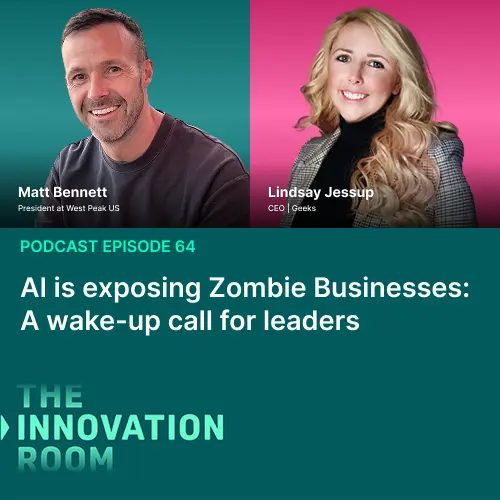
What is Generative AI? From models to trusted adoption
Generative AI has quickly become one of the most transformative forces in modern technology. By enabling machines to create text, images, software code, and even designs, it’s reshaping how organisations innovate and deliver value. According to McKinsey, generative AI could contribute up to $4.4 trillion in annual productivity gains across the global economy, unlocking new efficiencies in knowledge work, customer engagement, and product development. From healthcare to manufacturing, leaders are racing to understand how this new class of intelligence can elevate both creativity and performance.
Yet, while adoption is accelerating, the real challenge is no longer about experimenting with tools but integrating them responsibly. Many businesses still struggle to align generative AI initiatives with measurable outcomes, ethical standards, and long-term strategy. The next wave of value will belong to those who build trusted systems - models that are explainable, secure, and deeply tied to business goals. This guide explores how organisations can move from curiosity to confidence, turning generative AI into a reliable driver of growth and innovation
What is Generative AI?
Generative AI refers to systems that learn from large datasets to create new and original outputs such as text, images, music, software code, or product designs. Unlike traditional AI models that only analyse data to make predictions or classifications, generative models are designed to produce something new that mirrors the patterns found in the data they have been trained on.
At its core, generative AI relies on deep neural networks that recognise complex relationships within data. These networks identify underlying structures such as:
-
Tone and context in language, allowing tools like ChatGPT to generate human-like responses.
-
Shapes, lighting, and texture in images, enabling visual tools like Midjourney to produce lifelike artwork.
-
Logic and structure in code or text, which models like Google Gemini use to perform reasoning and solve complex problems.
What sets generative AI apart from narrow or task-specific systems is its capacity to create. While traditional AI focuses on single, repetitive tasks like fraud detection or demand forecasting, generative models generate new ideas, insights, and possibilities. This creative capability is what positions generative AI as a foundation for the next stage of intelligent automation and innovation.
What are foundation models in Generative AI?
Foundation models are large-scale neural networks trained on vast and diverse datasets that allow them to understand and generate complex patterns across different types of information. These models form the base layer of most generative AI systems, giving them the ability to perform multiple tasks once fine-tuned for specific goals. Examples include GPT (OpenAI) for language, PaLM (Google) for reasoning and text understanding, and Claude (Anthropic) for safe, context-aware interactions.
Foundation models typically fall into three main categories:
-
Language models trained on text data to perform tasks like summarisation, translation, and dialogue generation.
-
Vision models that learn from image and video data to identify, generate, or enhance visual content.
-
Multimodal models that combine text, image, audio, and code inputs to reason across multiple types of information simultaneously.
Their strength lies in scalability and adaptability. Once trained on a massive corpus of data, a foundation model can be fine-tuned for almost any domain, from legal document analysis to drug discovery, without needing to start from scratch. In essence, these models act as the building blocks of modern AI, enabling organisations to move faster from experimentation to production while maintaining consistency and performance across different applications.
What is the difference between Generative AI and other types of AI that generate content?
While generative AI is often associated with content creation, not every system that produces content qualifies as truly generative. Many traditional automation tools or rule-based AI systems can generate outputs such as reports, summaries, or visuals, but they rely on predefined templates or logic rather than learning patterns from data. The key difference lies in how content is produced - generative AI learns and creates, while other systems follow programmed instructions.
|
Aspect |
Generative AI |
Traditional Content-Generating AI |
|
Core Mechanism |
Learns patterns and relationships from large datasets using deep neural networks. |
Uses predefined rules, templates, or statistical methods to generate content. |
|
Creativity and Novelty |
Produces unique and original outputs that were never explicitly programmed. |
Generates repetitive or formulaic outputs based on fixed logic. |
|
Data Dependency |
Requires vast and varied training data to understand context and style. |
Operates on limited, structured datasets or fixed input-output mappings. |
|
Adaptability |
Can adapt to new prompts, industries, and styles with fine-tuning. |
Performs only within the boundaries of its programmed instructions. |
|
Examples |
ChatGPT, Gemini, DALL·E, Claude, Synthesia. |
Rule-based chatbots, email template generators, report automation tools. |
|
Use Cases |
Creative writing, image synthesis, predictive design, code generation. |
Static report creation, data visualisation, automated responses. |
|
Output Nature |
Context-aware, conversational, and often indistinguishable from human-created work. |
Consistent but limited to structured or repetitive tasks. |
|
Learning Capability |
Continuously improves with more data and feedback. |
Cannot learn beyond the rules defined by developers. |
In essence, generative AI learns to create, while traditional content-generating AI executes to produce. The former brings imagination and adaptability to technology, while the latter ensures structure and consistency in repetitive processes.
Generative AI use cases across industries
Generative AI is no longer confined to labs or pilot projects, it is becoming a core enabler of productivity, innovation, and decision-making across every sector. According to Gartner, over 70% of businesses plan to embed generative AI into their workflows by 2026, transforming how products are designed, services are delivered, and insights are generated. Its ability to automate creativity and simulate outcomes is helping organisations move faster, operate smarter, and deliver value in new ways.
How can generative AI be used in healthcare?
In healthcare, generative AI is accelerating the pace of medical discovery and diagnosis. It is being used to simulate drug compounds, generate synthetic patient data for research, and support diagnostic imaging with precision. Early experiments show that generative AI could reduce drug development time by up to 50%, allowing new treatments to reach patients faster. Personalised treatment recommendations powered by multimodal models are also improving patient outcomes while reducing clinical workloads.
How can generative AI be used in construction?
Generative AI is reshaping how construction projects are designed and delivered. Through AI-driven Building Information Modelling (BIM) and design automation, architects and engineers can explore thousands of design variations based on safety, cost, and sustainability factors. Studies show that AI-enabled BIM models reduce design iteration time by nearly 30%, helping firms cut costs and meet sustainability standards. In addition, predictive safety systems powered by generative simulation help identify potential hazards before work begins.
How can generative AI be used in cybersecurity?
In cybersecurity, generative AI is strengthening digital resilience. It enables threat simulation, automated vulnerability reporting, and adaptive anomaly detection that evolve alongside emerging attack patterns. Security teams are using these models to predict how adversaries might exploit weaknesses, allowing faster, pre-emptive action.
To identify high-impact and secure AI opportunities in your organisation, explore Geeks’ AI Consulting Services.
How can generative AI be used in manufacturing?
Generative AI is transforming manufacturing from the factory floor to the supply chain. Through generative design, engineers can automatically produce and test product prototypes that optimise strength, weight, and cost before production begins. In predictive maintenance, AI models learn from equipment data to forecast potential failures, reducing downtime and waste. When combined with digital twins, generative systems help manufacturers optimise entire supply chains, achieving faster innovation cycles and stronger operational resilience.
What is the strongest way for organizations to reduce consent-related risks when using Generative AI?
As generative AI systems learn from vast amounts of data, one of the biggest risks lies in how that data is sourced, used, and governed. Unclear consent processes, unverified datasets, or improper handling of personal information can expose organisations to regulatory, ethical, and reputational harm. Reducing these risks requires a combination of governance, transparency, and accountability built into every stage of the AI lifecycle.
The strongest way to reduce consent-related risks is to establish a clear data governance framework that defines ownership, permissions, and compliance responsibilities before any model training begins. Key practices include:
-
Implement strict data provenance checks to ensure that all datasets used for training are properly licensed, anonymised, and consented.
-
Adopt explainable AI principles so stakeholders understand what data influences each output and how it’s used.
-
Use privacy-enhancing technologies such as differential privacy, data masking, and synthetic data generation to protect sensitive information.
-
Maintain continuous oversight with human review processes for data collection, model outputs, and post-deployment monitoring.
-
Document consent and usage terms to create an auditable record of compliance with data protection laws such as GDPR and CCPA.
Beyond compliance, building trusted adoption means creating systems where privacy is not an afterthought but a design principle. Organisations that prioritise ethical data use from the start are better positioned to earn customer trust and unlock the long-term business value of AI responsibly.
The path to trusted Gen AI adoption
Trust is the foundation of meaningful gen AI adoption. It ensures that every system is fair, explainable, compliant, and aligned with business goals. Without trust, even the most advanced models can create risk instead of value. Achieving it requires balance between technology and governance, managing bias, protecting data, and keeping human oversight at the centre of decision-making.
Geeks supports this through frameworks like DiGence® and the AI Adoption Wheel, which help organisations assess readiness, build ethical governance, and deliver measurable ROI from AI. These frameworks turn experimentation into structured progress, ensuring that innovation happens responsibly and delivers long-term value. Learn how Geeks helps businesses move from testing ideas to enterprise-scale transformation through our AI Consulting Services.
Challenges businesses face with Generative AI adoption
Many organisations are eager to adopt generative AI but struggle to turn proof-of-concepts into meaningful outcomes. The difficulty often lies in weak foundations rather than the technology itself. When strategy, skills, and governance are not aligned, progress slows and value is lost.
Common challenges include:
-
A missing or incomplete data strategy that limits model accuracy and scalability.
-
Skills shortages that make it difficult to maintain or expand AI initiatives.
-
Poor system integration between legacy software and new AI tools.
-
Limited governance and accountability around data use and model decisions.
-
Pilot projects that show potential but never progress to enterprise deployment.
-
Low model transparency, making it hard to explain or validate outputs.
-
Weak ROI tracking, leaving leadership uncertain about business impact.
These challenges are solvable with the right structure and guidance. In a recent discussion with our CEO, I shared practical insights on how organisations can build the foundations needed for scalable and trusted AI adoption. You can listen to a short snippet from that conversation below, and if you’d like to hear the full podcast, visit Preparing for AI in Action Part 2.
Moving from experimentation to strategy
Generative AI delivers value when it is tied to clear business outcomes. Many organisations test new models without a defined strategy, which limits long-term impact. Progress requires structure, measurable goals, and a shared understanding of how AI supports the organisation’s priorities.
Through Artificial Intelligence Consulting , Geeks helps businesses move through a structured process: Assess → Align → Act → Repeat. Using frameworks like DiGence® and the AI Adoption Wheel, we help identify where AI can create value, measure readiness, and build systems that are trusted and sustainable. Generative AI’s true potential lies not in what it can create, but in how intelligently it is adopted.
Conclusion
Generative AI is reshaping how organisations innovate, make decisions, and deliver value. Its potential is vast, but success depends on responsible use and a strategy that connects technology to measurable business goals. Companies that approach adoption with structure, governance, and trust will gain the most lasting advantage.
Geeks helps organisations move from understanding to execution with proven frameworks that make AI adoption clear, ethical, and ROI-driven.
Ready to turn Generative AI into measurable business outcomes?
Partner with Geeks through our Artificial intelligence consulting services to assess your readiness, identify high-impact opportunities, and build a roadmap for trusted AI adoption.
FAQs
What does a Generative AI consulting company do?
A Generative AI consulting company helps organisations identify where AI can create value, design practical use cases, and implement models responsibly. Consultants guide teams through data readiness, governance, integration, and change management to ensure AI becomes part of the business strategy rather than a disconnected experiment.
How secure is Generative AI for enterprise use?
Generative AI can be highly secure when supported by strong data governance, controlled access, and continuous monitoring. Enterprises should prioritise secure model training, anonymised data handling, and compliance with privacy regulations to reduce exposure to security and consent-related risks.
How can LLMs be applied in enterprise settings?
Large Language Models (LLMs) can automate complex workflows such as document summarisation, report generation, customer support, and knowledge management. When fine-tuned for domain-specific data, they can improve productivity and decision quality across departments.
What are the risks of adopting Generative AI without a strategy?
Without a clear strategy, AI adoption often leads to isolated pilots, inconsistent results, and compliance gaps. A structured roadmap ensures that every model aligns with business goals, risk frameworks, and measurable ROI.
How do I know if my business is ready for Generative AI?
Readiness depends on data maturity, technical infrastructure, and leadership alignment. Frameworks like DiGence® and the AI Adoption Wheel help evaluate where your organisation stands and what needs to improve before scaling.
What industries benefit most from Generative AI consulting?
Sectors such as healthcare, finance, construction, and manufacturing gain significant value from AI consulting. Each benefits differently, from faster drug discovery and fraud detection to design automation and predictive maintenance.
How do consulting firms measure ROI from LLM projects?
Consulting firms measure ROI through improvements in efficiency, accuracy, and decision speed. Metrics often include time saved, error reduction, cost efficiency, and measurable revenue growth resulting from AI-driven insights.
What are examples of foundation models?
Prominent examples include GPT-4 by OpenAI, PaLM 2 by Google, Claude 3 by Anthropic, and Gemini by Google DeepMind. Each supports a range of applications across text, image, and multimodal domains.
How can companies measure ROI from Generative AI?
ROI can be tracked by comparing time, cost, and performance metrics before and after adoption. It also includes indirect value such as improved innovation, better decision-making, and stronger customer experiences.










